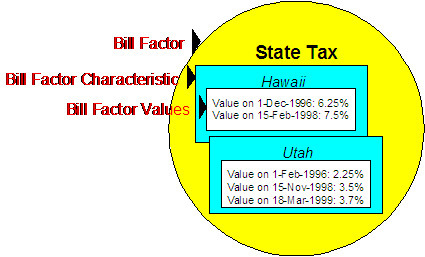The Structure of a Bill Factor
All bill factors share a common structure as illustrated below:

The above example shows a standard bill factor, which is made up of the following tables:
• Bill Factor. A bill factor contains descriptive information and attributes that control how the bill factor may be used in the system.
• Bill Factor Characteristic. All bill factors have the capability of having different values depending on some characteristic of the premise or service point. For example, a bill factor used to levy a state tax would have a different tax rate depending on the state in which the customer resides. A bill factor characteristic must exist for every state with a tax (states without a tax will not be linked to the state tax bill factor). At billing time, if the system cannot find a bill factor characteristic that corresponds with the customer's state of residence, the charge will be skipped.
• Bill Factor Value. Each bill factor characteristic may have many bill factor values over time. To continue with our state tax example, each state with a tax can have different tax rates over time. There are different ways in which a bill factor's values may be defined:
◦ For bill factors whose values are applicable to many customers where only one value is effective on a given date (such as, a city tax) the values are defined using bill factor values. Refer to Defining Bill Factor Values for more information.
◦ For bill factors whose value differs per customer, the value is defined in the customer's service agreement. Refer to Service Agreement - Contract Value for more information about bill factors in contract terms.
◦ For bill factors whose values are applicable to many customers where more than one value is effective on a given date (such as, an interval price or a weighted average price) the values are defined on an interval value set. Refer to Defining Interval Values for more information about interval value sets.
Parent topic